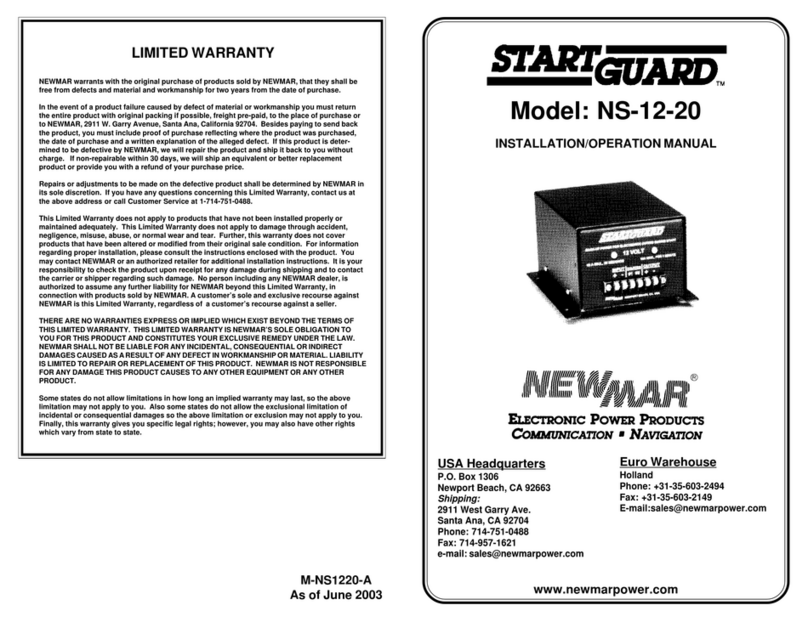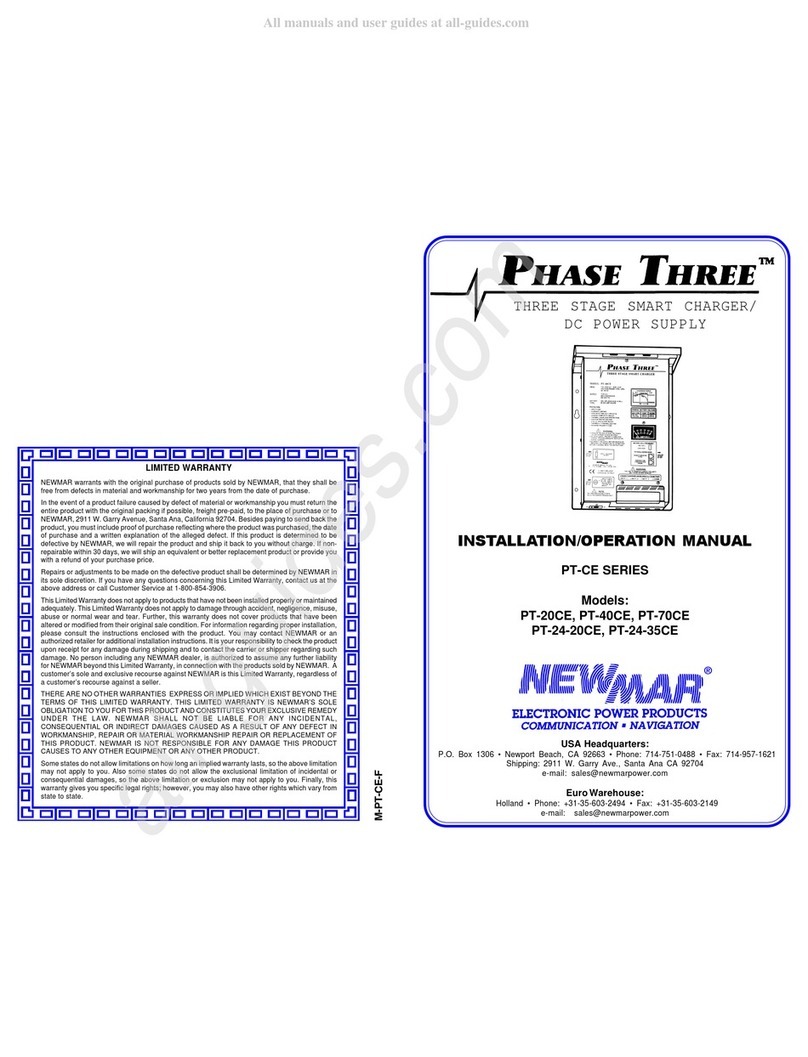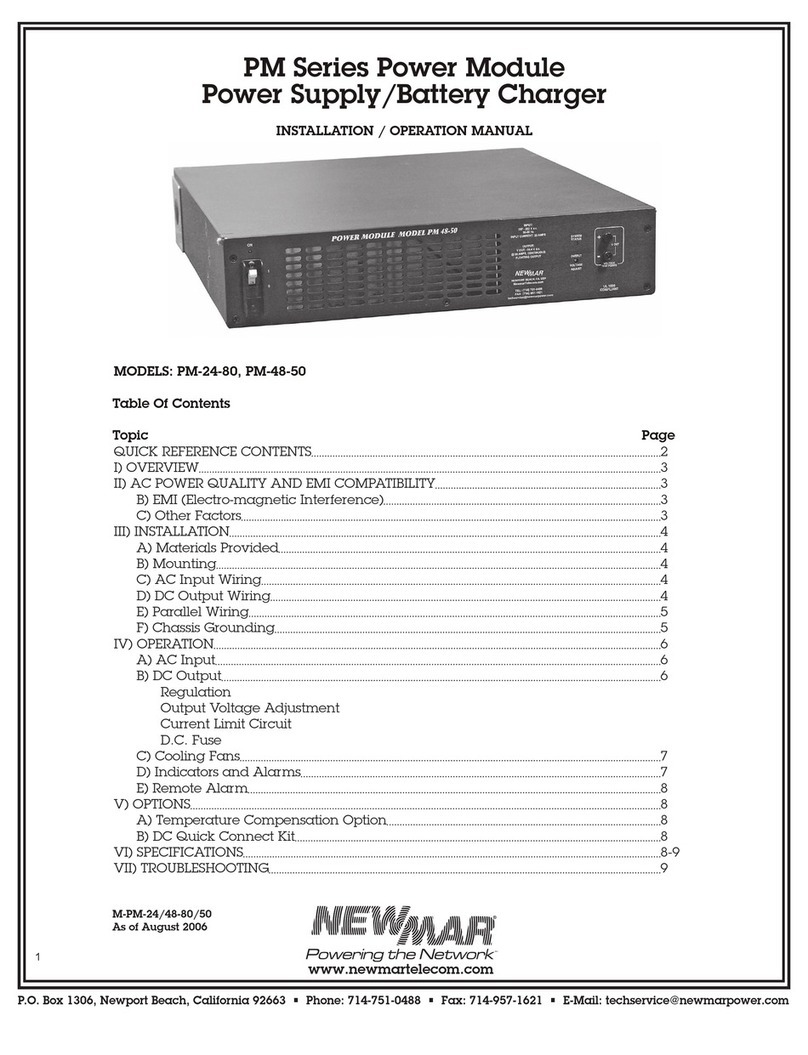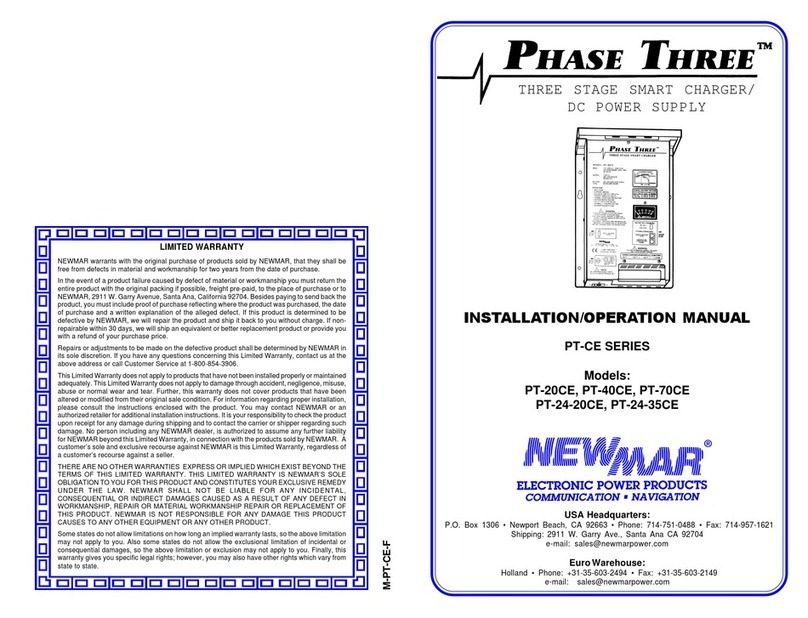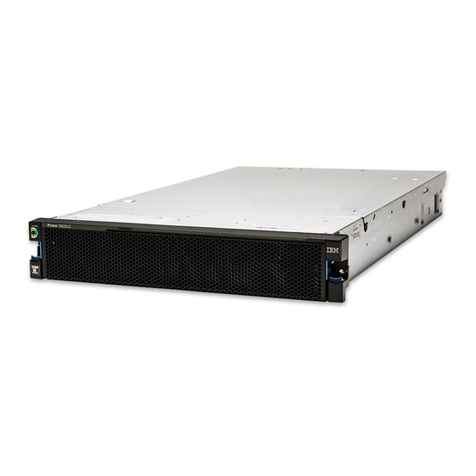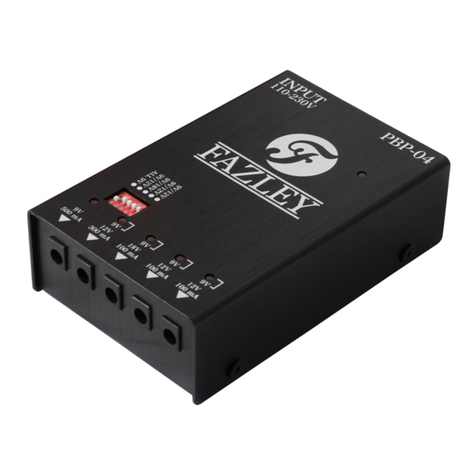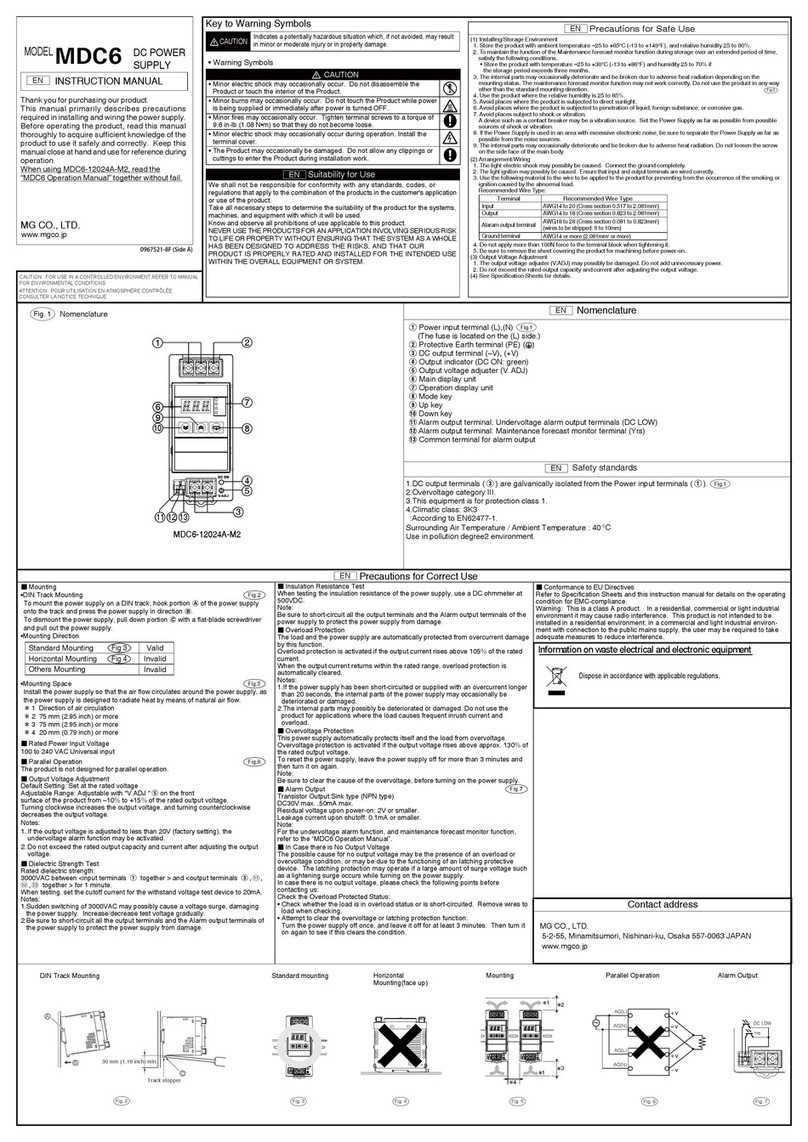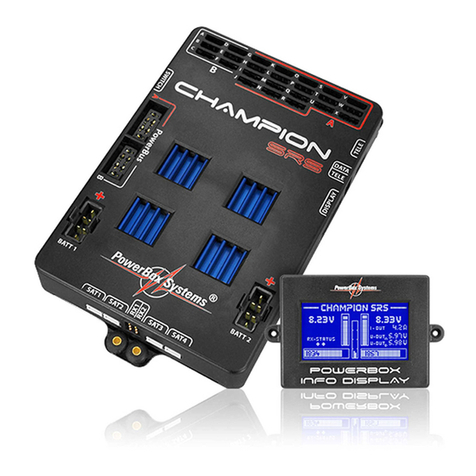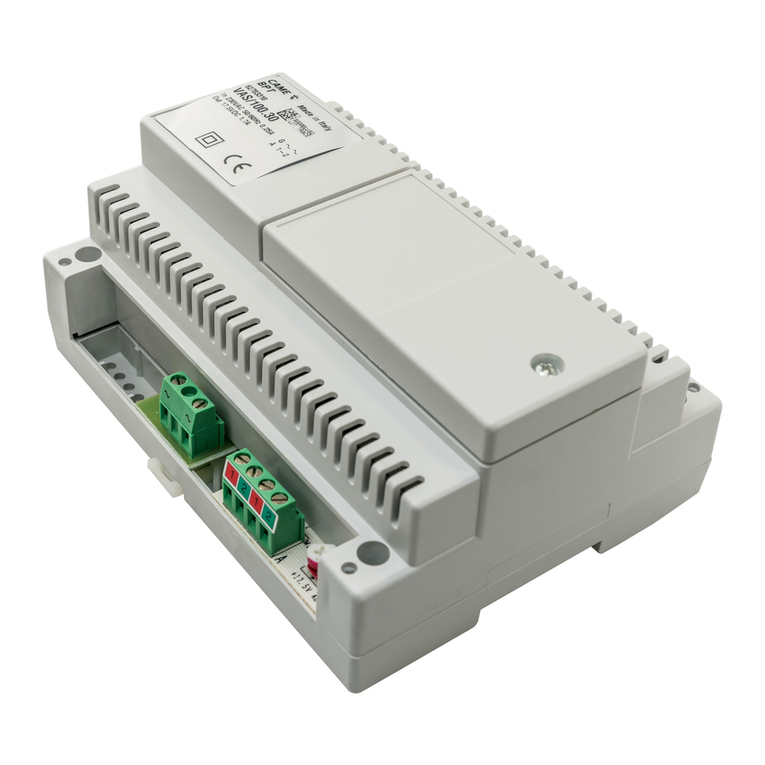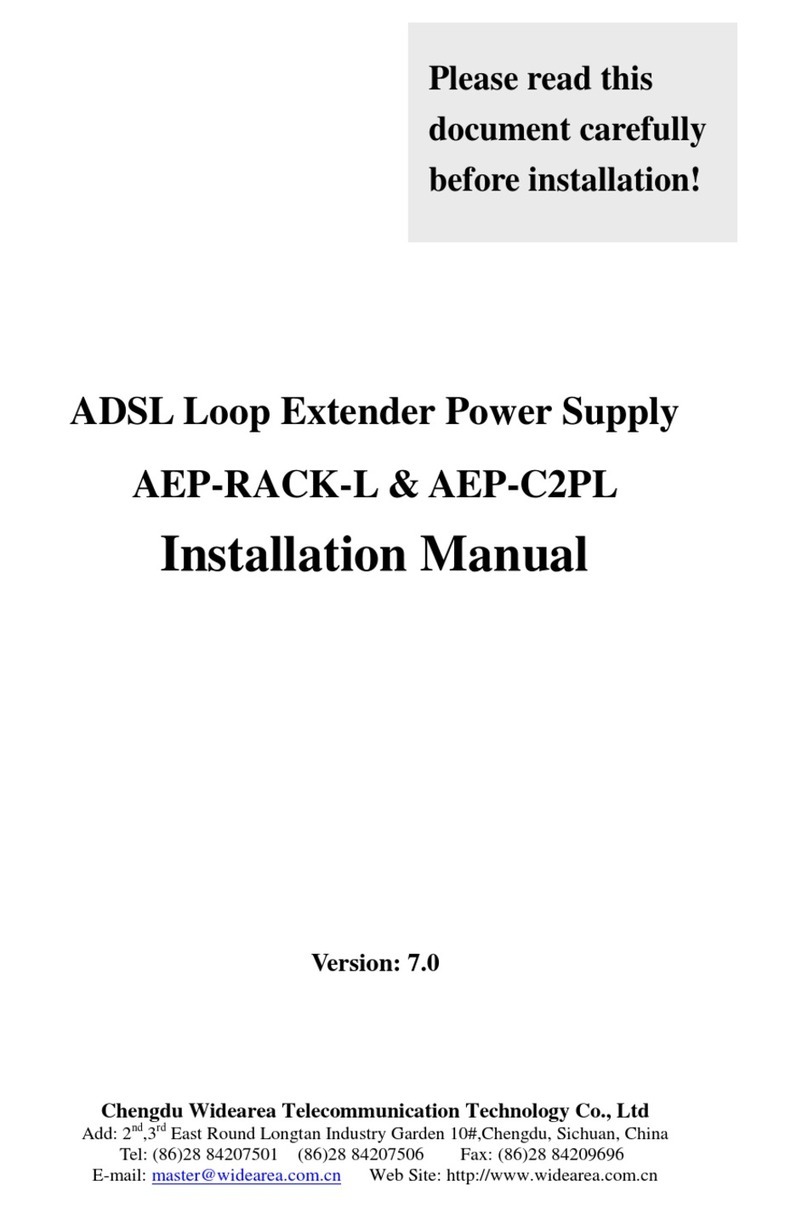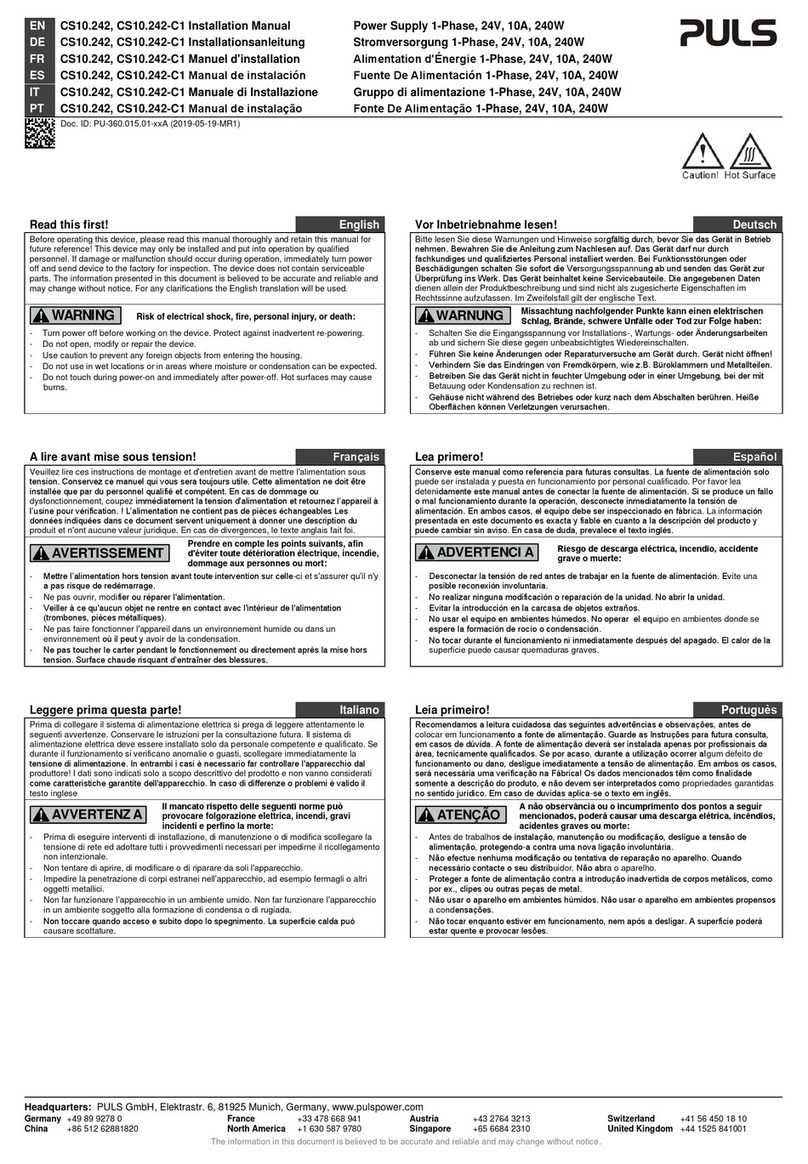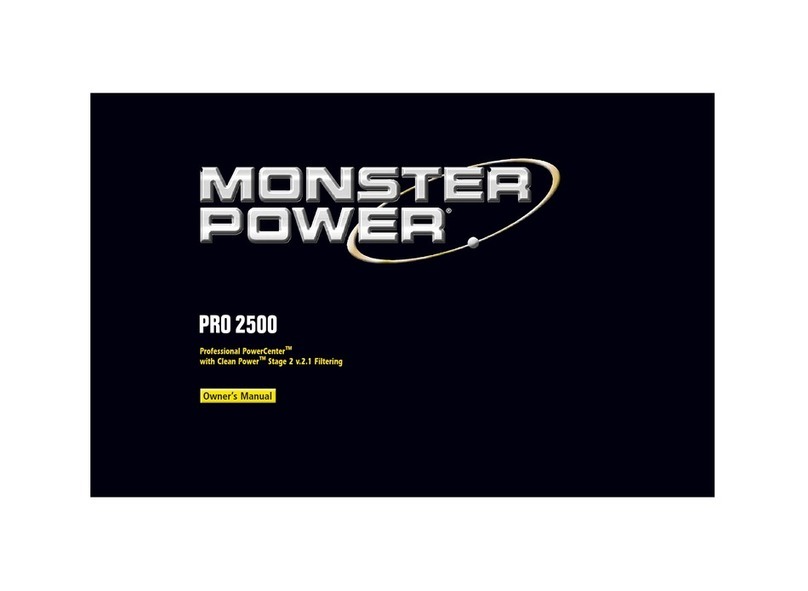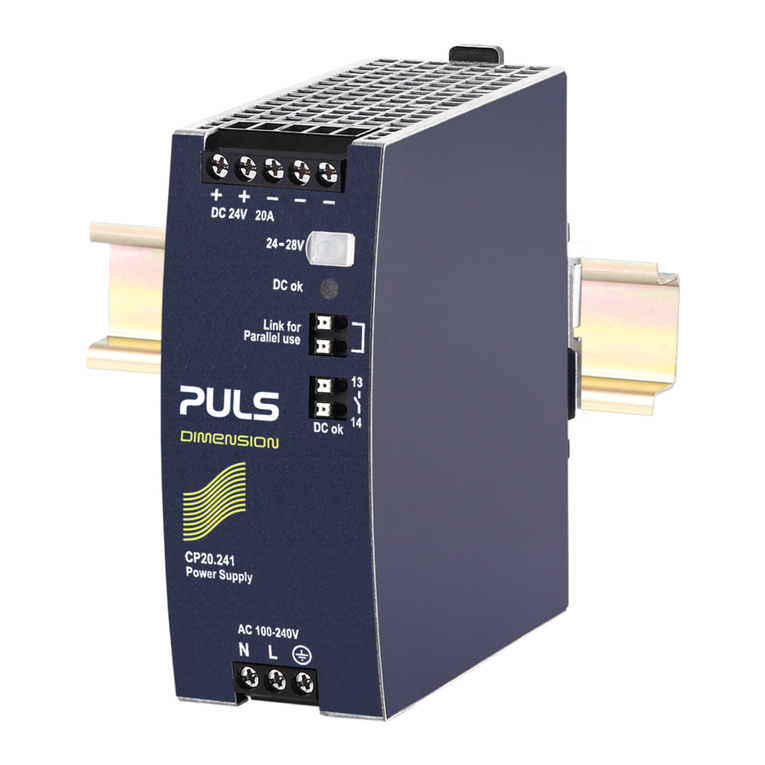NewMar Centurion III C3RS-48-124 User manual

1
Newmar • 1580 Sunflower Ave, Suite 100, Costa Mesa, CA 92626
Phone: 714-751-0488 • E-mail: techservice@Newmarpower.com
854-3906
M-C3RS Rev B as of 082123
Centurion III Power System
POWERING THE NETWORK
www.poweringthenetwork.com | 800.854.3906
Costa Mesa, CA
DC Power System
Installation / Operation Manual
Model:
C3RS-48-124 (-48VDC, +24VDC, & +12VDC)
RoHS
Copyright © NewMar 2021 All rights reserved.
Manual Version 1.0
Release Date: 24 May 2022
Disclaimer: NewMar reserves the right to make changes to the information within this document without notice
Product Compliance

2
Newmar • 1580 Sunflower Ave, Suite 100, Costa Mesa, CA 92626
Phone: 714-751-0488 • E-mail: techservice@Newmarpower.com
TABLE OF CONTENTS
1. ADMONISHMENTS 2
2. SAFETY 2
3. RECEIVING INSTRUCTIONS 3
3.1. Package Inspection 3
3.2. Equipment Inspection 3
3.3. Handling 3
3.4. Identification Labels 3
4. SCOPE 3
5. SYSTEM OVERVIEW 4
5.1. Power System 4
5.2. Physical Dimensions and Weights 4
5.3. Alarms and Status Indicators 5
5.4. EM4x Features 5
5.5. Rectifier Modules 6
6. INSTALLATIONS 7
6.1. Unpacking & Installing in Frame 8
6.2. AC Cabling 8
6.3. Upstream Over-current Protection 8
6.4. Discrimination 8
6.5. DC Cabling 8
6.5.1. Terminal Block Labeling 8
6.5.2. Terminal Block Max Wire Size/Recommended Torque Specification 9
6.6. Alarm/Ancillary Cabling 11
6.7. Temperature Sensors 11
7. ENERGY MANAGER CONNECTIVITY AND THE WEB UI 11
7.1. Access Levels 11
7.2. Ethernet Port Connection 12
7.3. USB Connection 12
7.4. Energy manager & IO PCB Alarm Output Configuration 13
7.5. EM4x LED Alarm Mappings 13
7.6. EM4x Main PCB Alarm Mappings 14
7.7. EM4x Main PCB Digital Input Alarm Mappings 15
7.8. Circuit Breaker Fail Monitoring 15
8. LVD OPERATION 15
9. MAINTENANCE 16
9.1. System 16
9.2. EM4x Controller 16
9.3. Rectifiers and Converters 17
9.4. Batteries 17
9.5. Ventilation Maintenance 17
10. TROUBLE-SHOOTING AND SERVICING 17
10.1. Servicing 17
11. ESSENTIAL SYSTEM SET-UP PARAMETERS 18
11.1. Systems with Lead Acid Batteries 18
11.2. DC System Lead Acid Battery Commissioning Checklist 21
11.3. Systems with Lithium Batteries 23
Appendix 1 AC INPUT TRANSIENT PROTECTION 24
Appendix 2 RECTIFIER INPUT FUSE CURVES 27
Appendix 3 INSTALLATION OF AC Junction Box 28
Appendix 4 TROUBLESHOOTING 29
Appendix 5 Field Replacement of Load Circuit Breakers 30
Appendix 6 System Wiring Diagrams 31

3
Newmar • 1580 Sunflower Ave, Suite 100, Costa Mesa, CA 92626
Phone: 714-751-0488 • E-mail: techservice@Newmarpower.com
ADMONISHMENTS
The admonishments are the symbols and wording used in this manual to alert readers to specific
dangers and instructions. The meanings of the various admonishments are explained as follows:
Warning = risk to life or personal injury and equipment
damage
Caution = risk of equipment damage.
= risk of electrical shock potentially causing death
or injury.
= alert of risk potentially causing death or injury.
= risk of burn injury from hot surfaces
= an alert that must be understood and
undertaken.
= instruction of mandatory reading of product
manual.
= risk of electrostatic
damage to components.
Proper precautions must be
taken.
= access for children prohibited.
= restricted access area.
= tip over hazard.
1. SAFETY
All installation and maintenance must be carried out by suitably qualified personnel.
For your protection, the product manual should be read and thoroughly understood
before unpacking, installing, and using the equipment.

4
Newmar • 1580 Sunflower Ave, Suite 100, Costa Mesa, CA 92626
Phone: 714-751-0488 • E-mail: techservice@Newmarpower.com
The energy manager contains static sensitive components that require careful handling
and proper precautions to be taken. A grounding strap should be worn.
The equipment is intended only for use in a restricted access area. The equipment is not
suitable for use in locations where children are likely to be present.
2. RECEIVING INSTRUCTIONS
Newmar provides all equipment to the delivering carrier securely packed and in
perfect condition. Upon acceptance of the package from Newmar, the delivering
carrier assumes responsibility for its safe arrival. Once the equipment is received,
it is the recipient’s responsibility to document any damage the carrier may have
inflicted, and to file the claim promptly and accurately.
NOTE: the period to make a claim against damage by a transport carrier can be short,
a matter of days, and varies by transport method, the transport contract, and local
laws.
2.1. Package Inspection
Examine the shipping crate or carton for any visible damage: punctures, dents, and
any other signs of possible internal damage.
Describe any damage or shortage on the receiving documents and have the carrier
sign their full name.
2.2. Equipment Inspection
Open the crate or carton and inspect the contents for damages. While unpacking,
be careful not to discard any equipment, parts, or manuals. If any damage is
detected, call the delivering carrier to determine the appropriate action. They may
require an inspection.
NOTE: Save all the shipping materials for the inspector to see.
After the inspection has been made, if damage has been found, contact Newmar.
We will determine if the equipment should be returned to our plant for repair or if
some other method would be more expeditious. If it is determined that the
equipment should be returned to us, ask the delivering carrier to send the packages
back at the delivering carrier’s expense.
If repair is necessary, we will invoice you for the repair so that you may submit the
bill to the delivering carrier with your claim forms.
It is your responsibility to file a claim with the delivering carrier. Failure to properly
file a claim for shipping damages may void warranty service for any physical
damages later reported for repair.
2.3. Handling
Handle the equipment with care. Do not drop or lean on front panel or connector.
Keep away from moisture.

5
Newmar • 1580 Sunflower Ave, Suite 100, Costa Mesa, CA 92626
Phone: 714-751-0488 • E-mail: techservice@Newmarpower.com
2.4. Identification Labels
Model number and serial number are clearly marked on all equipment. Please refer
to these numbers in all correspondence with Newmar. Ideally provide a photograph
of the product label for reference.
3. SCOPE
This manual covers essential information for the installation and commissioning of
the Newmar Power System Centurion III.
Note: System set-up for the controller, power modules and other ancillary devices are
provided in separate manuals. Where appropriate these are supplied with the system.
4. SYSTEM OVERVIEW
The system is intended to be a complete power system in a box, so no connections
need to be made internally.
All the AC, DC (Load and Battery) connections are made at the rear of the unit.
Alarm connections are accessible from the front by pulling the Energy Manager
forward.
The system is designed to be extremely simple to install and set up.
Note: This system is supplied with the AC and DC earths connected unless chassis DC
isolation is specified when ordering. The standard -48 VDC system output has the DC
Common in the positive side of the circuit (+ve earth system). The earth link can be removed
from the system to isolate earths.
4.1. Power System
Standard Features
The base unit is supplied with the following standard options:
AC Input: single-phase input terminals: Line, Neutral and Earth.
DC Output: maximum power output of 4.0kW producing a maximum current output of
83.4A/-48V.
Two power bays will accept -48V to 12V or -48V to 24V DC-DC Converters.
EM4x energy manager system controller (fully integrated in the system)
Battery Low Voltage Disconnect 125A rating
2x 100A Battery Circuit Breaker.

6
Newmar • 1580 Sunflower Ave, Suite 100, Costa Mesa, CA 92626
Phone: 714-751-0488 • E-mail: techservice@Newmarpower.com
10x DC Load Circuit Breakers, these may be specified as different values (from 2A to 30A)
at time of order.
2x DC-DC Converter Output Breakers with tripped breaker alarm
4.2. Physical Dimensions and Weights
Model
Centurion III
Depth (Total) 350mm
Width (Total) 483mm (19” mount)
Height 88.9mm (2U)
Weight without
rectifiers/converters
8.4kg
Weight with max.
rectifiers/converters
13.2kg
Table 1
Energy Manager
4.3. Alarms and Status Indicators
• Status LEDs:
◦ Red LED Urgent alarm state.
◦ Orange LED Non-Urgent alarm
◦ Green LED DC power is connected to the unit; Energy Manager is functioning
NOTE: The LED mapping can be user modified.

7
Newmar • 1580 Sunflower Ave, Suite 100, Costa Mesa, CA 92626
Phone: 714-751-0488 • E-mail: techservice@Newmarpower.com
• The energy manager is fitted with an audible buzzer which can be configured to alert to any
alarm depending on the alarm mapping.
NOTE: To disable the buzzer when active, tap any button.
• Micro-USB Connector: can independently power the EM4x and provides access to the Web
UI
Note: when there are multiple alarms raised the Active Alarm display cycles through the
list. The complete list can be viewed by tapping Alarms.
• Tap the buttons to navigate through the menus.
Note: the EM4x-01 has the option to PIN lock function change through the front screen
interface. See the EM4x manual for details.
4.4. EM4x Features
The EM4x microcontroller-based DC system energy manager provides the control and
monitoring functions for all Newmar Energy’s power systems. With an appropriate
communications connection third party lithium battery can also be managed.
The EM4x monitors all power system conditions including DC voltage, rectifier current,
battery current, battery temperature, distribution failure and battery pack status. It has an in-
built web-based configurator allowing setup of system parameters, monitoring, updating and
download of logs using a web browser as well as a front panel interface through which key
parameters are also configurable. Visual notification of alarm conditions is given by LEDs and
a display mounted on the front of the EM4x, with remote notification being enabled by relay
contacts, RS232 or TCP/IP (using SNMP).
The EM4x utilizes a USB communications port which allows for local monitoring of system
operations as well as pre-commission and power down configuration of the Web UI.
The EM4x also incorporates the following features:
• Support for third-party external batteries, both lead-acid and lithium based
• Support for AC-DC rectifiers (48V Outputs)
• Support for DC-DC converters (12V & 24V)
• Network connectivity (web access)
• System voltage metering for primary system DC supply. (e.g., 48V primary DC output)
• Load, battery and rectifier current metering and alarms
• Active rectifier current share
• Automatic system voltage control
• Effectively unlimited alarm thresholds as standard, for use with multiple DC outputs
• Advanced monitoring, display and logging of battery packs, and system performance data
• Advanced hybrid site control and monitoring with patented anti-stall feature for
generators.
• Phase balance controls for multi-phase and single-phase AC input management
• Sophisticated programmable logic control
• For lead-acid external batteries -
◦ Battery and room temperature metering and alarms (when fitted with optional
temperature sensors)
◦ Temperature compensation of float voltage (when fitted with optional temperature
sensors)
◦ Manual equalize charging to prolong the life of the batteries
◦ Periodic equalize charging to prolong the life of the batteries
◦ Fast charging after battery discharge
◦ Battery capacity remaining indication
◦ Battery testing facility
◦ Battery current limit
• Six user defined General Purpose Inputs (“GPIPs”) which can be software configured as
either digital or analogue inputs* (up to 10 may be made available under special
circumstances)
• Six relay outputs*

8
Newmar • 1580 Sunflower Ave, Suite 100, Costa Mesa, CA 92626
Phone: 714-751-0488 • E-mail: techservice@Newmarpower.com
4.5. Rectifier Modules
The RM2048HE is a telecommunications grade rectifier with the following features:
• High efficiency
• Hot pluggable
• Forced air cooled
• Thermally protected
• Power factor corrected
• Wide input AC voltage
• Constant power output limit
• Input/Output voltage and current protected
• Active load sharing
• Serial alarm and control interface
• Microprocessor controlled
There are 3 LED indicators on the front panel which indicate the operational state of the
rectifier:
Red
LED
Urgent alarm state.
Yellow
LED
Non-Urgent alarm.
Green
LED
DC power is connected to the unit.
This LED flashes during power save mode.
5. INSTALLATIONS
WARNING - All upstream AC, Load and Battery breakers must be switched OFF
prior to installation.
The system must be completely de-powered.
All circuit breakers in a Newmar power system must be in their OFF position prior to
installation.
WARNING - Use extreme care when fitting batteries & their connections. Remove all
conductive materials from yourself such as watches, jewelry, and rings prior
to
RM3048HE
3.0
kW 48V DC
Status LEDs
Fan Cooled
Unlock Button
R M
2
048HE
2
.0kW 48V DC
Figure 4: RM2048HE Rectifier

9
Newmar • 1580 Sunflower Ave, Suite 100, Costa Mesa, CA 92626
Phone: 714-751-0488 • E-mail: techservice@Newmarpower.com
commencing the installation. DO NOT short terminals when working on them.
CAUTION - Avoid resting cables on sharp edges (cold-creep)
The energy manager contains static sensitive components that require
careful handling and proper precautions to be taken. A grounding strap
should be worn.
5.1. Unpacking & Installing in Frame
Upon unpacking, check that the unit is not damaged, and that you have the required
number of rectifiers.
The unit flush mounts into a standard 19” mounting frame. The mounting screws
should be #12-24; however, #10-32 may be used with washers. Be sure to mount
the unit in the 19” frame squarely if #10-32 screws are used.
Please note the complete system weight is 13.2kg. (29 lbs.). Ensure the 19”
mounting rails can withstand mounting of the system.
A 5/32" (4mm) wide slotted screwdriver has been provided to allow ease of
accessing some of the smaller recessed DIN style terminal block screws.
Note: Do not fit rectifier modules until the Centurion III DC power system has been installed
into the rack.
5.2. AC Cabling
The AC terminals are clearly marked at the rear of the system as shown in Fig 1.0 & 1.1.
The terminals can accept up to 8 AWG/10mm2 cables.
Once cables are connected, ensure cable clamps are secured. Refer to appendix 5
for AC junction box cover removal (page 24)
The AC earth terminal earths the System chassis. The AC earth is also internally
bonded to the System chassis by earth stud as shown in Fig 1.1. The AC earth
terminal can accept several small cables or up to a single 2 AWG cable.
DC Common (+ve) is connected to the AC earth as shown in Fig 1.1 but can be
removed if output is required to be isolated.
Note: Refer Appendix 3 for AC Input Transient Protection
Figure 2 AC-DC Connection
Earth Stud
P
N
L
Figure 1 Terminal Block

10
Newmar • 1580 Sunflower Ave, Suite 100, Costa Mesa, CA 92626
Phone: 714-751-0488 • E-mail: techservice@Newmarpower.com
5.3. Upstream Over-current Protection
There are two considerations to consider when selecting an appropriate fuse/circuit
breaker.
- The upstream protection should protect the downstream cable from overload situations.
- Discrimination should be maintained with the downstream device fuses.
Cable Rating
The maximum current drawn by the DC power system is 24A from a single-
phase supply (12A per rectifier at a minimum input voltage of 175V
ac
and full
output power). The upstream protection device must be able to supply this
load under all conditions without tripping. Therefore, typically at least 20%
headroom is allowed for in the protection device, making its minimum rating
28.8A/ph for single phase input.
Note: The current carrying capacity of cables is dependent on the type of cable used.
Please check with your local supplier and local regulations for appropriate sizing.
5.4. Discrimination
Discrimination ensures that the upstream circuit breaker or fuse does not blow if
a rectifier input fails (short circuit). Therefore, it is important to ensure the
upstream protection discriminates with the internal fuse of the rectifier. The fuse
used in the RM2048HE is a slow-blow 15A fuse. The tripping curve for this is
shown in Appendix 4 at the rear of this manual.
A minimum circuit breaker to use for this system is a 32A, D-curve (note, a 32A C-
curve breaker will not discriminate with the rectifier fuse). Therefore, when used
with the 2.5mm2 cable supplied, a 20A, D-curve breaker should be used.
Alternatively, a 40A C-curve breaker, or greater, can be used. However, AC cable
provided may have to be replaced for a larger cable1.
If a fuse is used upstream, then any BS88 or NH g style fuse, of 20A or greater rating
will discriminate.
5.5. DC Cabling
CAUTION: Use extreme care when fitting batteries & their connections. Remove all jewelry
and rings from oneself prior to commencing the installation. Always use insulated tools
when fitting batteries and take extreme care not to short terminals when working on
them.
2x +12V/-12V or
1x +12/-12V & 1x +24V/-24V or
2x +24V/-24V
Battery Connections

11
Newmar • 1580 Sunflower Ave, Suite 100, Costa Mesa, CA 92626
Phone: 714-751-0488 • E-mail: techservice@Newmarpower.com
5.5.1. Terminal Block Labeling
Note: Your Centurion III Load & Battery Terminal Blocks may be labeled
differently than shown in photos on the following page. Some Centurion III
shelves’ terminal blocks are identified by Numbers which are the Live or Hot
terminals and the words Batt. Common or Load Common which are the Return
or Ground terminals – see polarity table below.
System Voltage “Numbered’ (AKA: Live or Hot) ‘Common’ (AKA: Return or Ground)
-48 VDC - +
5.5.2. Terminal Block Max Wire Size/Recommended Torque Specification
Connection Max AWG Recommended Torque
AC Input 8 10.5 in/Lbs.
AC Earth 2 22 in/Lbs.
Loads 1 – 12 8 10.5 in/Lbs.
Note: A larger breaker may be used even though in theory it may appear that the 2.5mm
wire is not fully protected. In fact, it is protected on two accounts. Firstly, it is protected
by the rectifier input fuse (which is only a short distance away). Secondly, the rectifiers are
power limited on their input. Therefore, they can never be overloaded. As a result, the wire
can never be over-loaded by the rectifier – it can only see fault current. As a result,
depending on local authorities, only fault current protection may be catered for by the
upstream protective device.
All live DC and Common connections are made to the connectors at the rear of the unit as
shown in Fig 2 and Fig 2.1.
For 1-8 load breakers 8AWG/10mm2 terminals are used whereas for 9-16 load breakers,
10 AWG/6mm2 terminals as shown in Fig 2 and Fig 2.1.
The battery terminals shown can accept cables up to 2 AWG/35mm2.
The internal battery cabling goes directly to the circuit breaker, then via a Low Voltage
Disconnect relay and current shunt to the internal live bus. This can be seen on the
wiring diagram at the rear of this manual & in Fig 5.
Ensure cables are strain relieved by utilizing the cable tie slots provided as shown in Fig 2.
5.6. Alarm/Ancillary Cabling
Alarm and communication cables terminate directly
into the terminals of the Energy Manager. These
terminals are accessible by pulling the monitor forward
to expose connections as shown in Fig 3, Fig 3.1, Fig
3.2 & Fig 3.2a. When routing the cables, ensure they
are kept away from the AC and DC power cables when
possible.
5.7. Temperature Sensors
Uncoil the battery temperature sensor tie wrapped to
rear of shelf and place in the middle of the middle
battery string. If the lead is not long enough, ordinary
2-core copper (approx. 18 AWG/0.75mm2) wire can Temperature Sensor
Alarm/Ancillary Cabling

12
Newmar • 1580 Sunflower Ave, Suite 100, Costa Mesa, CA 92626
Phone: 714-751-0488 • E-mail: techservice@Newmarpower.com
be used as an extension. The purpose of the battery temperature sensor is to monitor the
ambient temperature of the batteries over long periods of time and adjust the rectifier output
(float) voltage accordingly. As a result, it is not necessary to have the temperature sensor
touching the batteries. If the Battery Temperature Sensor is removed a “battery temp fault”
alarm is generated.
The “Ambient” temperature sensor (optional) can be used to monitor the temperature in
another location if required. Temperature sensors from the older Sm3x controllers are not
compatible with the EM4x controller.
6. ENERGY MANAGER CONNECTIVITY AND THE WEB UI
The energy manager is configured via a web browser-based user interface (Web UI). There are
two methods to access the Web UI:
• Ethernet connection from the J305 ethernet connector
• Front panel micro-USB local connection
6.1. Access Levels
There is 1 default access level for the energy manager Web UI from firmware version 10.0:
enaadvanced: this user has normal full control access of the system
The default password = W7h!GJ28KG
There are 3 access levels for the Energy Manager Web UI if upgraded from a version before
10.0:
enaguest : can only view status of system
enabasic : reduced privilege, can view settings and system status
enaadvanced : this user has normal full control access of the system
The default password for all levels = ena123
6.2. Ethernet Port Connection
The energy manager contains static sensitive components that require
careful handling and proper precautions to be taken – an electrostatic
discharge protection device must be worn.
Figure 16: Energy Manager Ethernet Port
Ethernet Port

13
Newmar • 1580 Sunflower Ave, Suite 100, Costa Mesa, CA 92626
Phone: 714-751-0488 • E-mail: techservice@Newmarpower.com
1. Connect the communicating device to the J305 Ethernet port inside the energy manager.
2. Open an internet browser such as Edge, Chrome, Firefox or similar on the device.
3. Enter the Ethernet default IP address into the internet browser.
Note: the energy manager IP address can be located from the front panel LCD menu under:
Settings>Networking>Ethernet.
4. The energy manager log in page appears.
5. Enter the username and password. See 7.1 Access Levels.
6.3. USB Connection
Figure 17: 1U EM4x-01 Front Panel micro-USB
1. Connect the communicating device to the micro-USB port on the front of the energy
manager. See Figure 17.
A driver installation prompt appears.
2. Double-click the appropriate USB driver (32bit or 64 bit).
3. Follow the installation wizard instructions to install the driver.
4. Open an internet browser such as Edge, Chrome, Firefox or similar.
5. Enter the USB default IP address into the internet browser: 172.31.250.1
6. The energy manager log in page appears.
6. Enter the username and password. See 7.1 Access Levels.
Note: USB connection to the energy manager is possible without AC, battery or other
external power supply. The EM4x operates drawing power through the USB port. However,
USB supply does not power the IO Board. In this scenario there is a set of alarms that display
depending on the system configuration relating to the nonoperation of the IO board.
For example:
Micro-USB

14
Newmar • 1580 Sunflower Ave, Suite 100, Costa Mesa, CA 92626
Phone: 714-751-0488 • E-mail: techservice@Newmarpower.com
For information on the use of the energy manager Web UI please refer to the Energy
Manager Installation and Operation Manual.
6.4. Energy manager & IO PCB Alarm Output Configuration
For full EM4x functionality and operation information, refer to the EM4x Installation and
Operation Manual.
6.5. EM4x LED Alarm Mappings
Refer to the Alarm Configuration>Alarm Configuration page of the Web UI to see the priority
setting of each alarm.
Refer to the Relay/Output page Configure Relay section of the Web UI to understand the
how the Alarm Configuration is mapped to the EM4x LEDs.
EM4x Yellow LED non-Urgent Alarm Mapping
EM4x Red LED Urgent Alarm Mapping
(
For reference only. Actual system alarm mapping may vary)
(
For reference only. Actual system alarm mapping may vary)

15
Newmar • 1580 Sunflower Ave, Suite 100, Costa Mesa, CA 92626
Phone: 714-751-0488 • E-mail: techservice@Newmarpower.com
6.6. EM4x Main PCB Alarm Mappings
Alarms can be mapped to any of the voltage free output relays fitted to the EM4x. Output
states of either Normally Open or Normally Closed can be selected (NO and NC states are for
the de-energized relay). A jumper is fitted to nominate the required output state, ensure the
jumper is placed in the correct configuration for installation requirements.
If an alarm is programmed for the relay to be normally energized (such as a low voltage alarm
where loss of power will put the alarm into its “active” state), then be sure to connect the
remote wiring appropriately.
Table 2 lists alarm assignment for the EM4x controller as matches the relay outputs shown in
Figure 18.
Figure 18: EM4x Relay Outputs
Table 2: IO Board 1 Relay Alarm Assignments
Relay
Output
Relay Label
(In NewMar Config.)
Alarms Mapped to Relay/Output
(All multiple states “OR-ed”)
Relay 1 CPU Fail
Relay 2 Non-Critical Alarms Orange LED
Relay 3 Critical alarms Red LED
Relay 4 Spare
Relay 5 Spare
Relay 6 Spare
Buzzer Red LED
Relay Outputs 1 -
6

16
Newmar • 1580 Sunflower Ave, Suite 100, Costa Mesa, CA 92626
Phone: 714-751-0488 • E-mail: techservice@Newmarpower.com
6.7. EM4x Main PCB Digital Input Alarm Mappings
General purpose inputs allow the Commander II & II+ system to monitor any external
equipment that includes relay or auxiliary outputs. The GPIP inputs are activated by
connecting the system positive (common) to the input terminal (configuration setup in the
EM4x can allow activation by connecting to system live).
General purpose inputs can also be configured as analogue inputs for purposes such as
battery midpoint monitoring and voltage monitoring.
These inputs may be assigned to contribute to alarm states within the monitor. The state
mapping is defined in the configuration file. Alarm mapping should be completed using the
EM4x software. Please refer to the EM4x manual for detailed information.
The inputs are normally activated by connecting system positive (usually system common) to
the input.
6.8. Circuit Breaker Fail Monitoring
Comment: Main circuit breakers (MCBs) are monitored electronically via a diode to a digital
input on the EM4x. The digital input will trigger an alarm when it is pulled to the system
common (positive) rail. The Breaker Fail alarm will only operate if a load is connected to the
output to provide a return circuit for the sense wire. Therefore, for breakers that do not have
a load connected, the breaker can remain in an OFF position without causing a false alarm.
The battery circuit-breakers, however, use voltage sense to detect tripping or whether they
are turned off. This is because when a battery breaker is tripped, there may be very little
voltage difference across the breaker, making electronic fail detection problematic. Hence, if
no battery is connected, the breaker must be ON to clear the Battery Breaker Fail alarm.
7. LVD OPERATION
The primary Low Voltage Disconnect contactor is in the battery side of the DC distribution. A
secondary Load Low Voltage Disconnect can be optionally included in a section of the load
side of the DC distribution.
The LVD contactor is a bi-stable, magnetically latching contactor. This means that failure of
power or removal of the EM4x from a live system will not cause the contactor to change
state. Periodic pulsing of the LVD control signal allows the monitor to ensure the contactor
remains in the correct state. The contactor is monitored by the EM4x to allow an alarm to be
generated when the contactor is open.
The EM4x energy manager unit is powered from both the rectifier side of the LVD contactor and
direct from the battery source. Following an extended AC outage and the low output voltage
threshold being reached, the primary LVD disconnects the battery from the system live bus and
the EM4x will lose voltage sense (as voltage sense is measuring system live bus voltage) yet still
maintains operation for system monitoring. The LVD contactor will not re-engage until rectifier
input supply is restored (i.e., until the DC bus voltage is re-established). LVD
adjustments/settings are all made in the supervisory module.

17
Newmar • 1580 Sunflower Ave, Suite 100, Costa Mesa, CA 92626
Phone: 714-751-0488 • E-mail: techservice@Newmarpower.com
8. MAINTENANCE
As Newmar power systems are state of the art electronic systems, little routine maintenance
is required.
8.1. System
• During normal operation the cable entries to the MCBs may loosen over time due to
movement in the cable strands. To avoid damage to the MCB’s and cable entries due to
heat build-up and arching, it is recommended that the retaining torque is periodically
checked at least annually.
• MCB’s should be maintained at a torque of 2Nm.
• All other connections should also be checked at this time.
8.2. EM4x Controller
• The controller can give a good indication of the condition of the system. Alarm logs can
show issues with the system and rectifiers and should be regularly checked.
• As a minimum, check that the float voltage and load current is as expected.
• If the batteries are fully charged, check the battery current is zero or near to zero amps,
and check that the amp-hours remaining is 100%.
8.3. Rectifiers and Converters
• During normal operation some dust will build-up on the front of the rectifiers. This should
be kept to a minimum by regularly wiping the rectifiers to avoid accumulation within the
rectifiers and blocking the airflow to the units. The positioning of the system and
surroundings will determine the regularity of this requirement.
• In extremely dusty positions it is recommended that the units are removed and cleaned
with compressed air to prevent airflow blockages.
• Check the air flow front and back to the rectifiers is unimpeded by cables or otherwise.
• Check nothing has entered the rectifiers such as insects or geckos.
8.4. Batteries
• Battery maintenance depends on the individual manufacturer’s specification, please
contact the battery supplier for recommendations.
• Periodic discharge tests may be beneficial to ensure reliable system operation and may
be recommended by the battery manufacturer.
CAUTION - The user must be aware of the consequences of battery State of Health
(SoH) with regards their specific load requirements and implement their own policy
regards the end of life of the batteries.
8.5. Ventilation Maintenance
Check that there has been no change in the required airflow space or environment that impacts
the ventilation.

18
Newmar • 1580 Sunflower Ave, Suite 100, Costa Mesa, CA 92626
Phone: 714-751-0488 • E-mail: techservice@Newmarpower.com
9. TROUBLE-SHOOTING AND SERVICING
If the red LED is alight:
• Unplug the rectifier and re-engage.
• Check AC power to the rectifier.
• Check for rectifier alarms in the monitor Urgent Alarm list.
• If symptoms persist, contact a service agent.
If the yellow LED is alight:
• Check the monitor Non-Urgent Alarm list.
9.1. Servicing
DANGER - Do not operate the rectifiers, converters, or other power modules if
the covers are damaged or removed in any way.
WARNING - The rectifiers, converters or other power modules contain voltages
that may be lethal even after the input supply has been removed.
WARNING - The rectifiers, converters or other power modules contain
components at high temperature that may burn if touched
To isolate a rectifier or converter from the power supply, unplug it from the shelf.
The power modules contain no user serviceable components. Do not disassemble the
modules.
If a power module has an operational fault or is damaged in any way, an authorized service
center should service it immediately.
10. ESSENTIAL SYSTEM SET-UP PARAMETERS
The following steps are system settings that must be checked at the time of commissioning
for each system installed. You can print this section and fill it out for each site
commissioned.
Note: these steps are battery chemistry dependent. Follow the appropriate section.
10.1. Systems with Lead Acid Batteries
Failure to correctly follow the items below may cause incorrect system functionality and, in
some cases, ruin your battery (without the ability to claim battery replacement under
warranty).
NOTE: Any values shown below are indicative only. If the values in your system differ from those
shown here, write in the values relevant to your system.
Refer to the EM4x energy manager manual for more details.

19
Newmar • 1580 Sunflower Ave, Suite 100, Costa Mesa, CA 92626
Phone: 714-751-0488 • E-mail: techservice@Newmarpower.com
Check the Battery Type
The system MUST be
configured to the correct
battery type.
EM4x Web UI page
Battery>Battery Settings
/
Check/Set Float Voltage
Consult battery manufacturer’s data for proper setting.
The Float voltage is for 25°C reference temperature in NewMar systems.
EM4x Web UI page: Control
Example:
Site Setting: /
Set Battery Temperature Compensation
Toggle temperature compensation
On.
EM4x Web UI page: Battery>Battery
Settings
You must consult the battery manufacturer’s data to obtain the correct Slope setting.
Note that in many Hybrid applications where the battery is constantly being cycled,
having temperature compensation enabled may not be necessary as the voltage on the
battery is constantly changing anyway.
EM4x Web UI page: Battery>Battery Settings
Example:
Site
Settings:
/
If you choose not to enable Temperature Compensation, then set the Rectifier Float Voltage to
that required by the battery manufacturer for the average long-term temperature you anticipate
your system to operate at.
Set Battery Capacity
Consult the battery manufacturer’s data for correct battery capacity settings.
For the EM4x to set the correct Battery Current Limit current, it is essential that this is
filled out correctly. These figures are also used for estimating the Battery Time
Remaining during a discharge.

20
Newmar • 1580 Sunflower Ave, Suite 100, Costa Mesa, CA 92626
Phone: 714-751-0488 • E-mail: techservice@Newmarpower.com
For Telecom applications, the 10-hour rate is usually the name-plate rating of the
battery. However, once again, check the battery manufacturer’s data sheets as some
manufacturers state the 20-hour rate (which is usually a little more “optimistic”).
The second rate is required specifically for the time-remaining algorithm. A 4-hour
rate is usually a good one to use. This information is available from the battery
manufacturer’s data sheet.
The Battery SoC adjust can be used at the time of installation (or for testing purposes)
in case the installed battery is not initially fully charged. If you think the battery is only
80% charged, then simply enter that value. The value displayed here will correct itself
once the battery has been on charge for some time or gone through a few
charge/discharge cycles.
Battery Recharge Efficiency considers the ohmic and any other losses in the battery
charge/discharge cycle. The effect is that more energy (Ah) needs to be put back into
the battery than was taken out. With the efficiency set to 96%, then 4% more Ah is
needed to be returned to the battery before the EM4x will register that the battery is
at 100% SoC (State of Charge).
The Battery Discharge Threshold is a buffer to prevent false triggering of discharge
notification and is usually related to the size of the battery shunt. A larger shunt
requires a larger discharge threshold.
EM4x Web UI page: Charge
Example:
Site
Settings:
/
Table of contents
Other NewMar Power Supply manuals
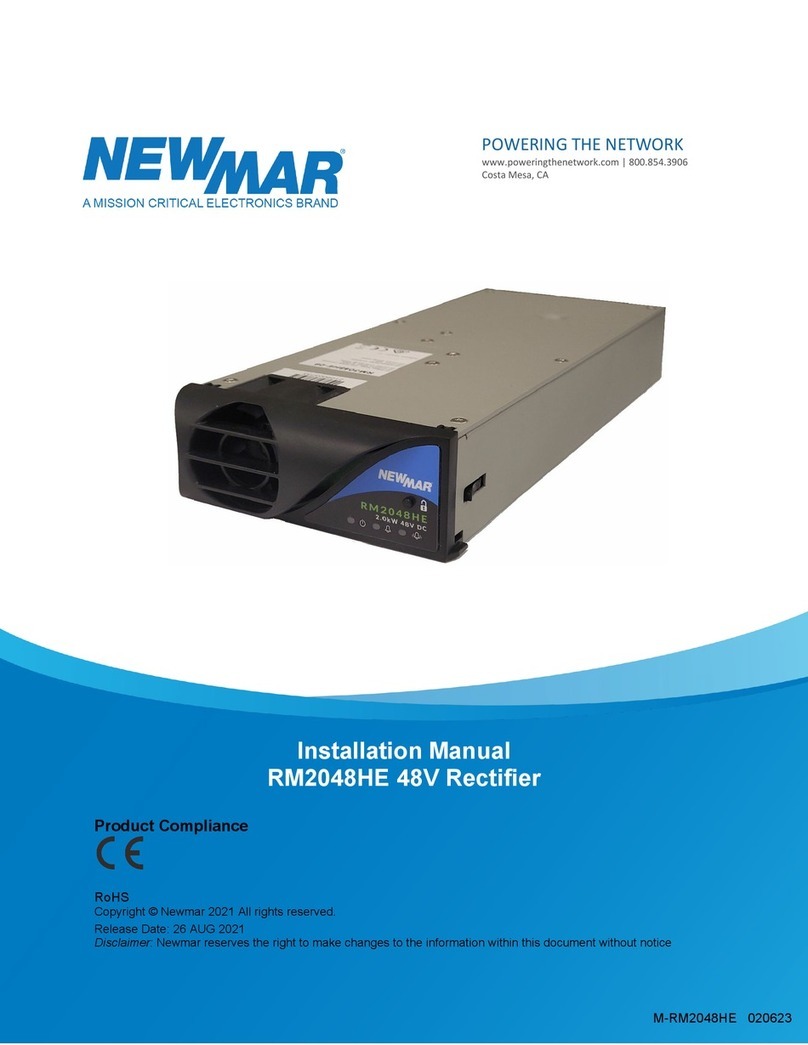
NewMar
NewMar RM2048HE User manual
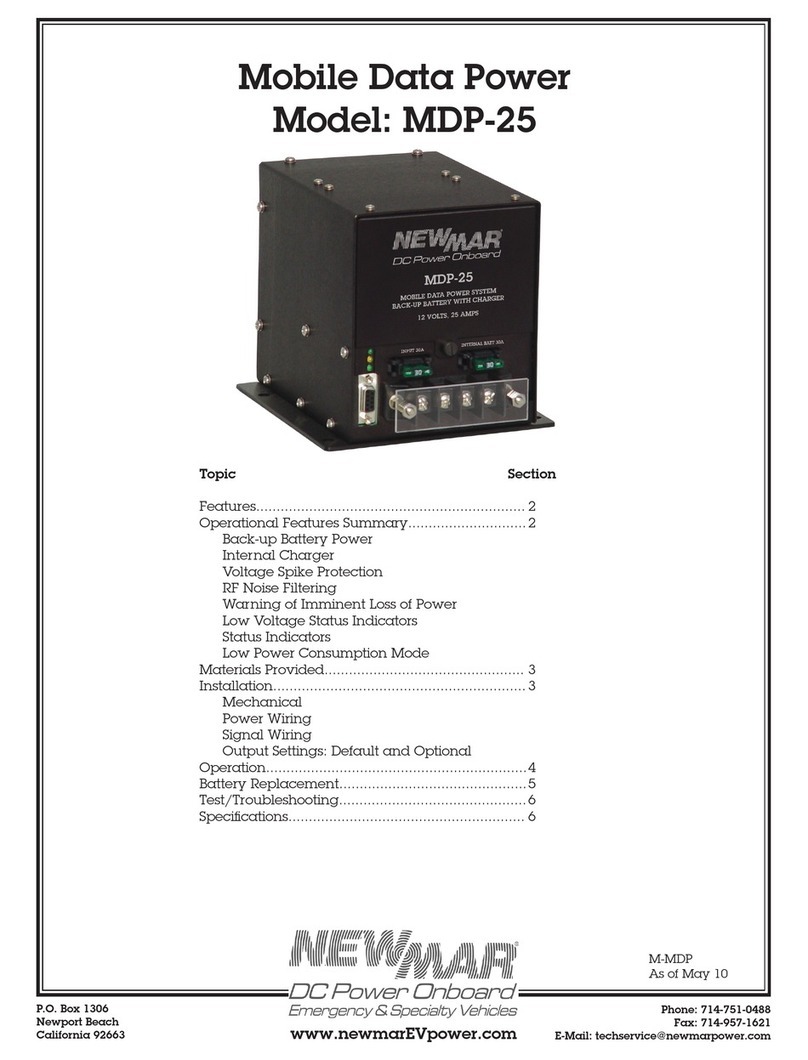
NewMar
NewMar MDP-25 User manual
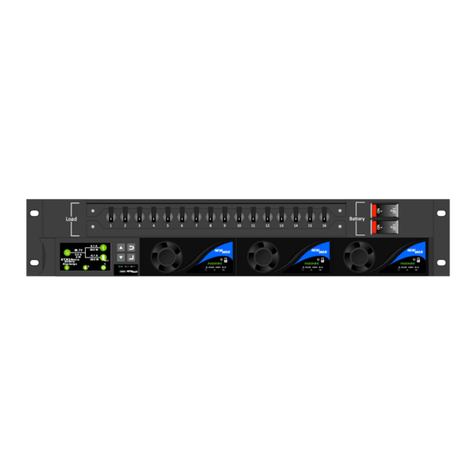
NewMar
NewMar Centurion II User manual
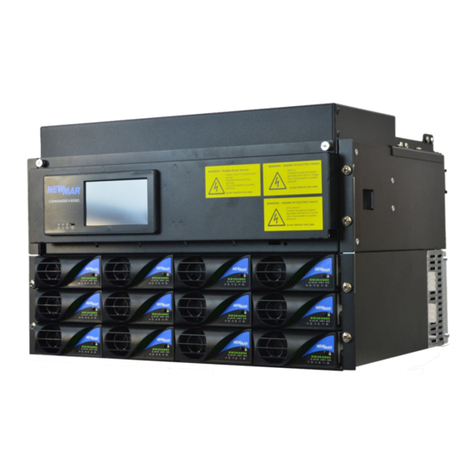
NewMar
NewMar Commander II Series User manual
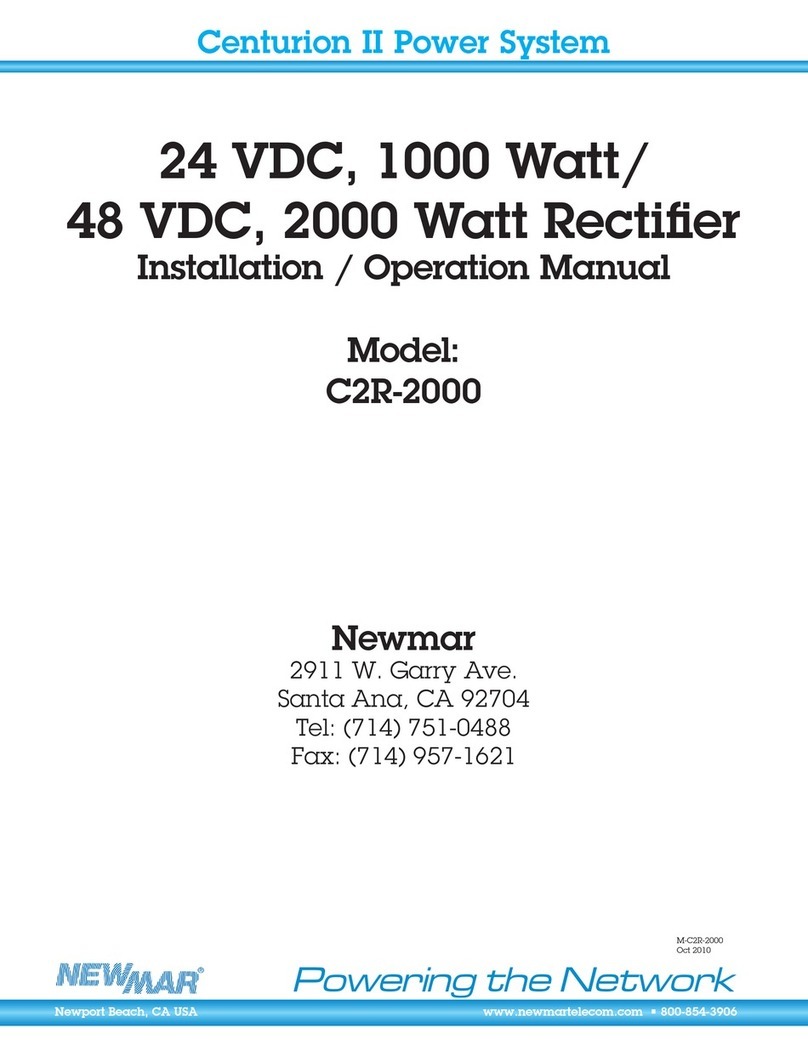
NewMar
NewMar C2R-2000 User manual
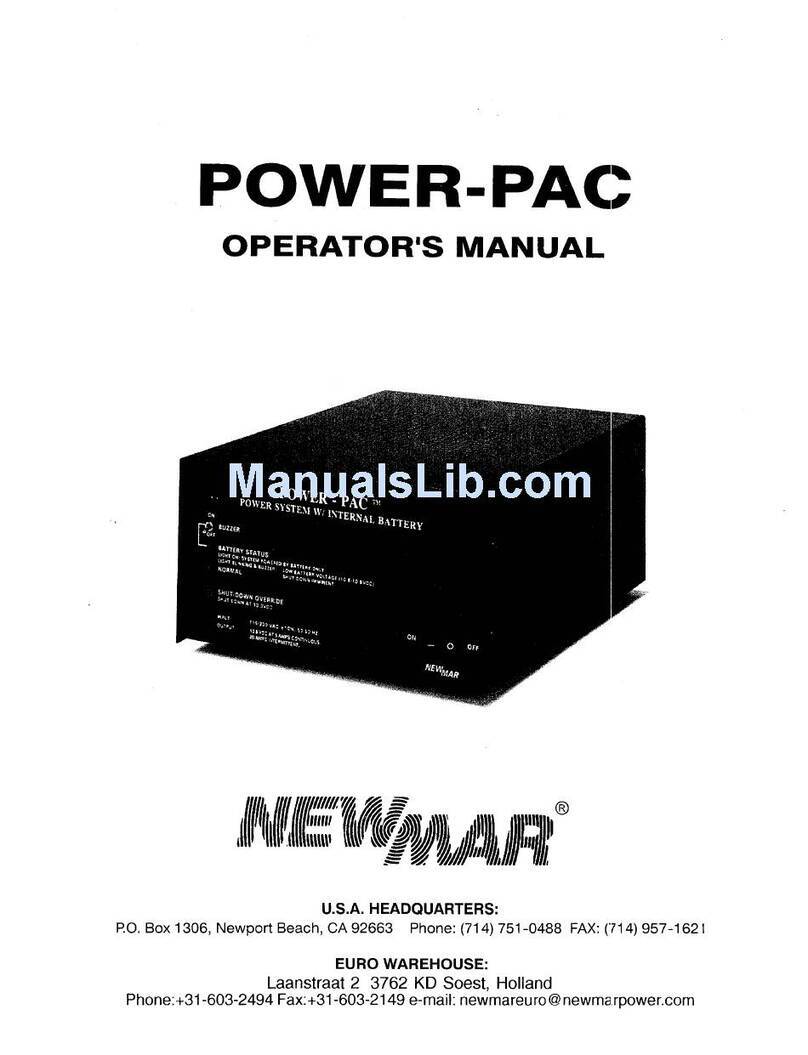
NewMar
NewMar power-pac User manual

NewMar
NewMar PM-12-40 User manual
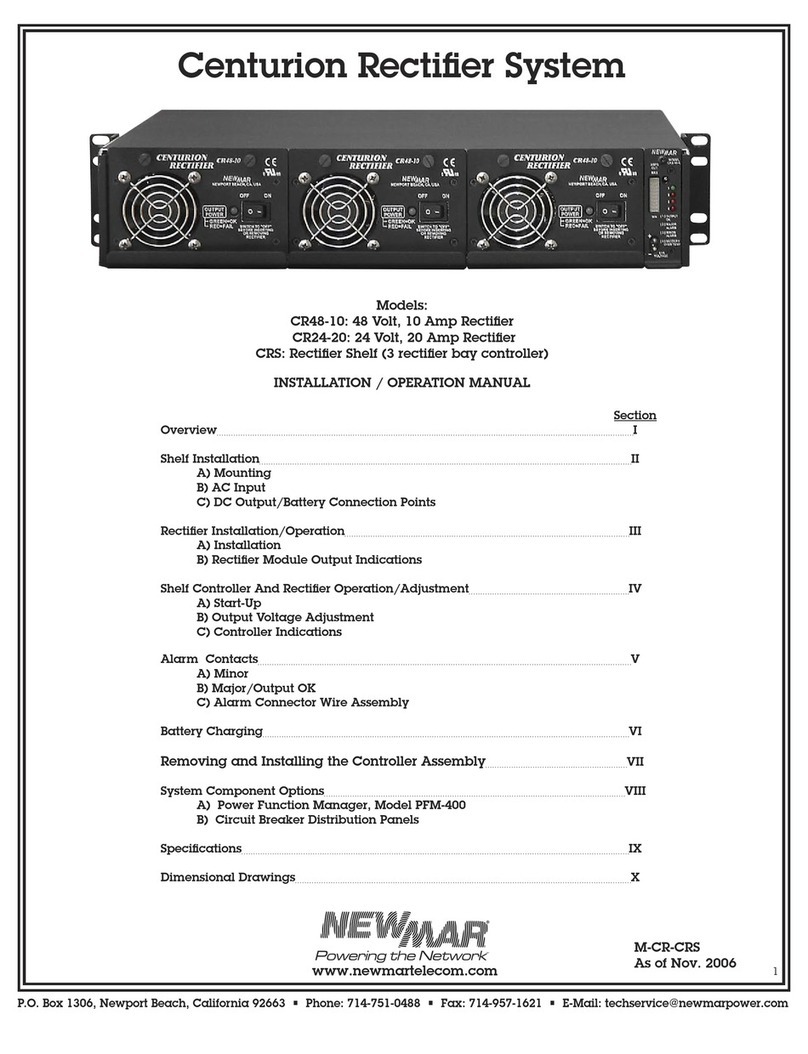
NewMar
NewMar Centurion CR48-10 User manual
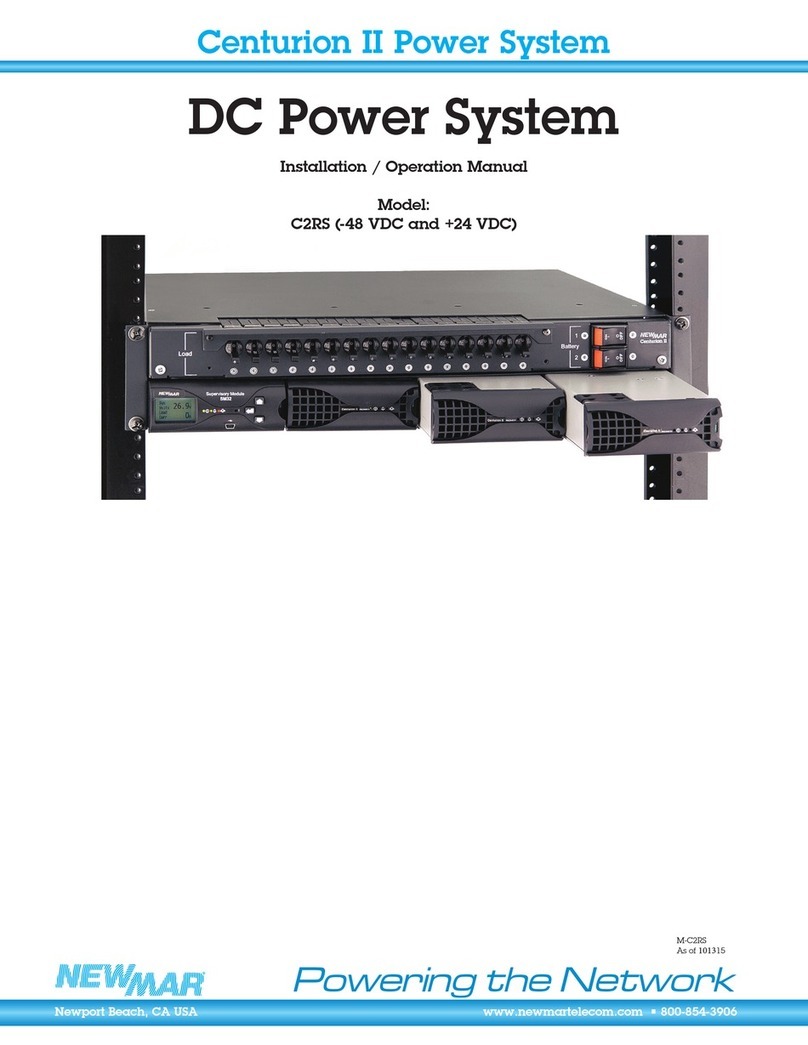
NewMar
NewMar Centurion II User manual
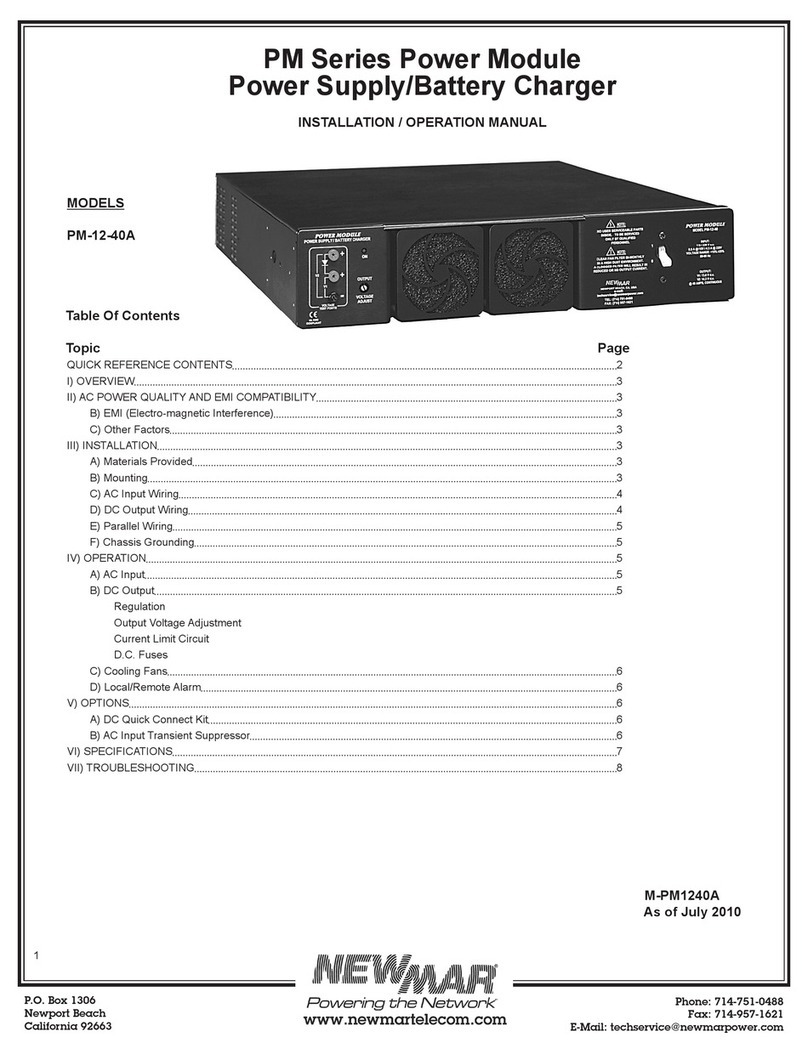
NewMar
NewMar PM-12-40A PM Series User manual
Popular Power Supply manuals by other brands

Akyga
Akyga AK-TB-06 user manual

Zte
Zte ZXDU68 B201 Product description

Lutron Electronics
Lutron Electronics Sivoia QED SVQ-10-PNL-230 installation instructions
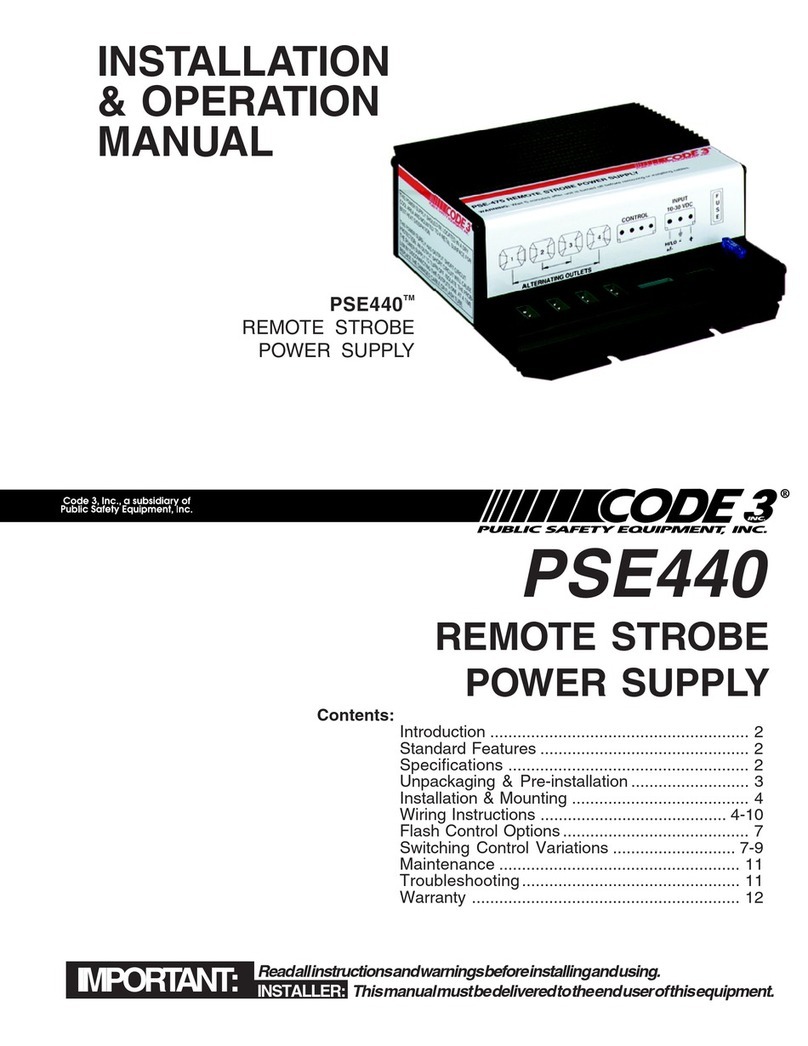
Code 3
Code 3 PSE440 Installation & operation manual
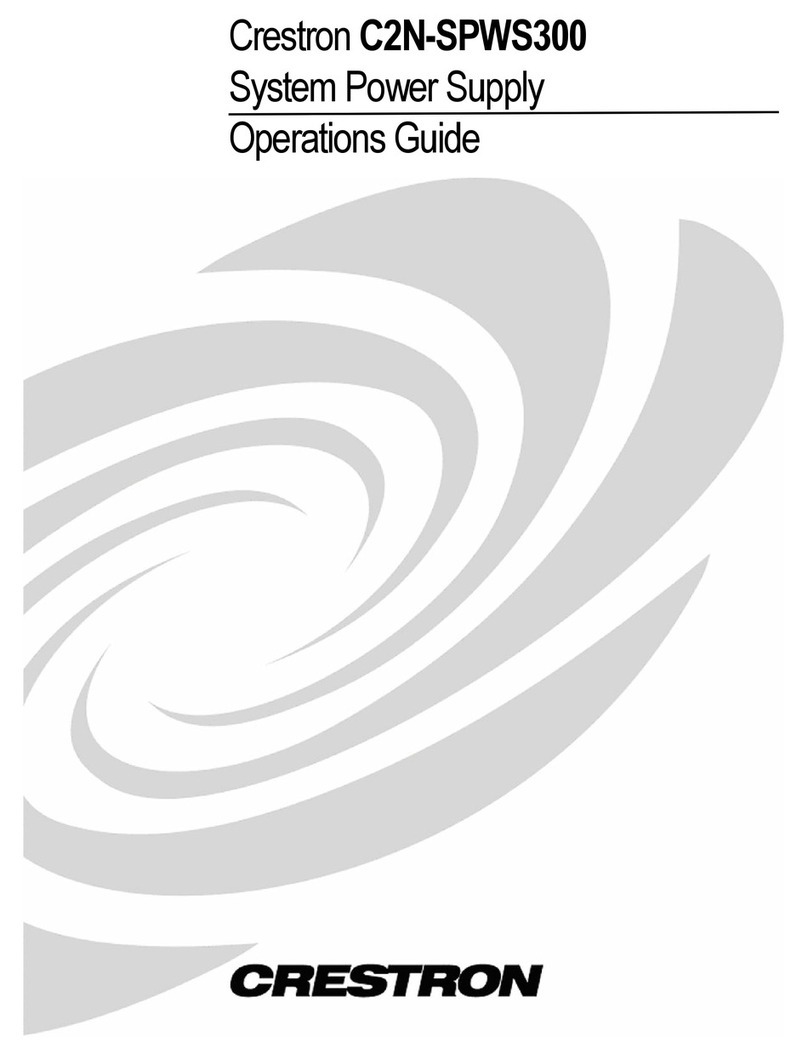
Crestron
Crestron C2N-SPWS300 Operation guide

MICRO-EPSILON
MICRO-EPSILON scanCONTROL 25 Series Assembly instructions
